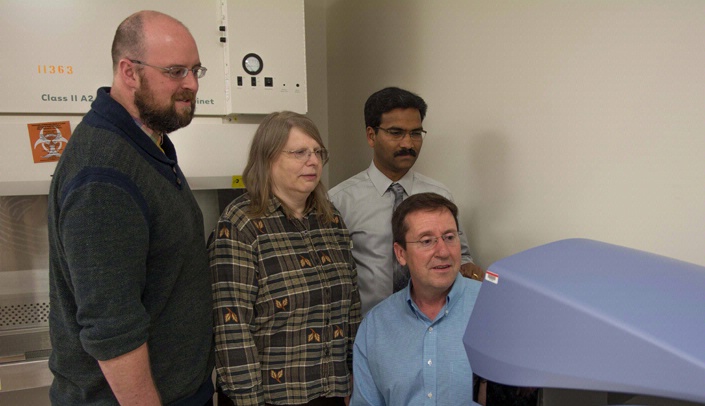It’s the latest in cutting-edge technology in single cell genomics.
And even though it doesn’t look like much — a blue inconspicuous machine with a touchscreen of buttons and blinking lights — the information it can extract from a single cell is beyond amazing.
Discover magazine
See this story and others on UNMC’s researchers in the latest issue of Discover magazine.
As recently as last year, a researcher who wanted to know what genes were important in a particular tumor would only be able to get a general idea of the tumor’s composition with the help of high-throughput gene expression profiling methods.
But researchers want more specific information.
“Typically a researcher analyzes a DNA/RNA sample extracted from a mixture of millions of cells, but so much more detailed information can be gleaned by analyzing the DNA/RNA from individual cells,” said Jim Eudy, Ph.D., director of the next generation DNA sequencing core facility.
Now, thanks to a $500,000 grant from the Nebraska Research Initiative, researchers at UNMC will be able to do just that.
With the C1 Single-Cell Auto Prep Integrated Fluidic Circuit, researchers now have the capability of deciphering the differences in groups of cells that appear similar but possess fundamentally different properties.
The journal Nature Genetics deemed single cell genomics the “Method of the Year” in 2014 and called it a turning point poised to transform many areas of biology and medicine.
“It’s the next big little thing,” Dr. Eudy said. “Single cell genomics technology is revolutionary.”
There is currently no other single cell genomics instrumentation in the state, he said, adding that the new technology will be used as part of an interdisciplinary team combining the expertise of the genomics, flow cytometry, confocal imaging and bioinformatics core facilities.
Hamid Band, M.D., Ph.D., director of the center for breast cancer research and associate director for translational research in the Eppley Institute at UNMC, said that because cancer cells exhibit a tremendous amount of cellular heterogeneity or diversity, the biological differences between those cells can be obscured using traditional sequencing methods.
Single cell genomics technology allows researchers a window into the mutational status and epigenetic landscape of individual cells that allows them to see such key properties of tumors as why some stay dormant for a long time only to recur years later, Dr. Band said.
“This will allow physicians to have advance information on which drugs will likely work as second or third line therapies in patients whose cancers recur.”
